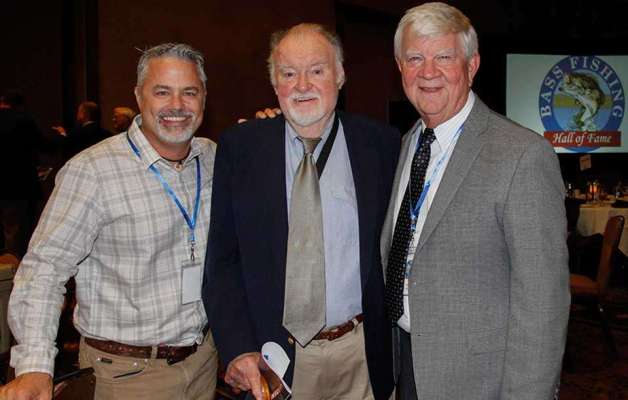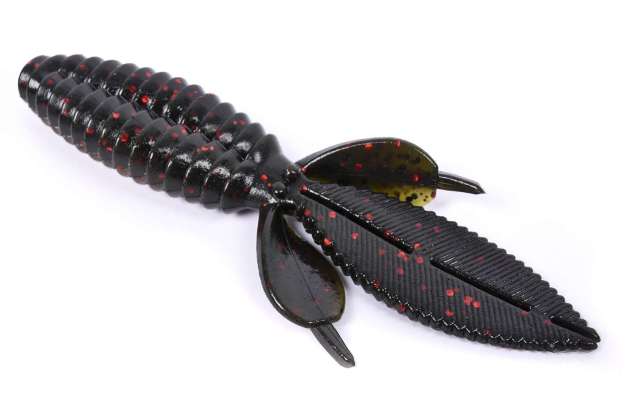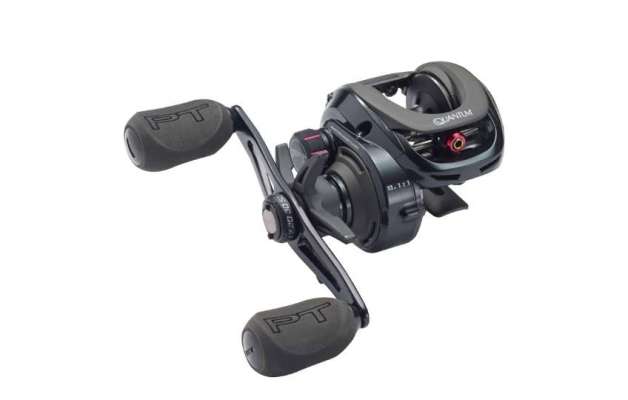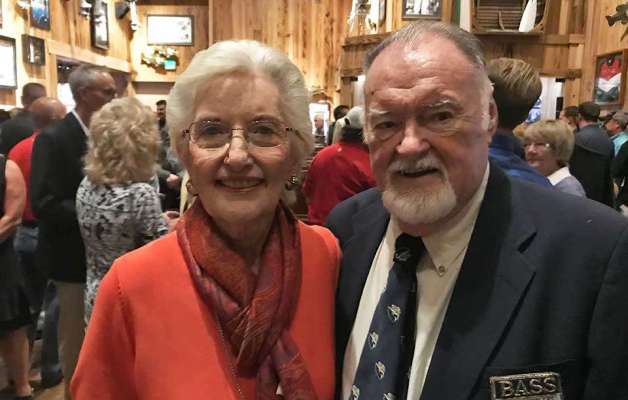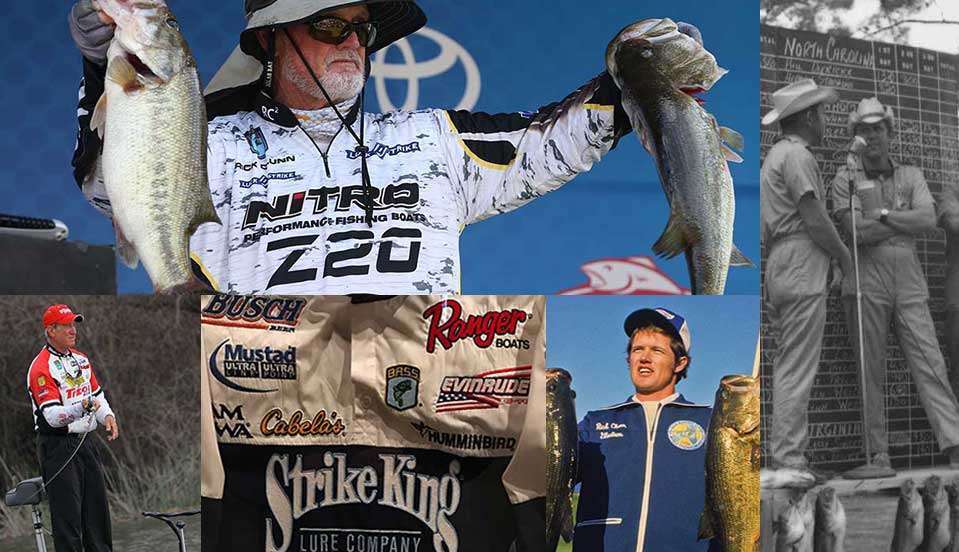
Editor’s note: 2018 marks the 50th anniversary of B.A.S.S. As part of our celebration we’re publishing stories, videos and photos about the history of the sport, including the one below.
Signage the one constant in evolution of angler clothing
Most everything has changed for bass anglers over the years, and that includes the shirts on their backs. For the 50th anniversary of B.A.S.S., the Daily Limit looked into the evolution of tournament clothing, from the jumpsuits at the beginning to today’s computer-generated, high-tech jerseys.
Many fishing excursions 100 years ago were done in suits and ties, but fishing attire was certainly more casual around World War II. In old photos, flannel shirts, like the red plaid ones worn by hunters of the day, were commonly seen along with white T-shirts or just about any shirt the owner didn’t mind getting slimed.
Once Ray Scott began holding national tournaments, there was impetus to conform, to create some sort of unity in uniform. Jumpsuits, adorned solely with a B.A.S.S. patch before sponsors started chiming in, became that first unofficial uniform for a good percentage of the anglers.
Dave Precht, longtime editor of Bassmaster Magazine, wasn’t at those first events, but he has certainly played a major role in chronicling the sport.
“The very first pictures I saw from those tournaments in Arkansas and other places that Ray ran, there was a mixture of jumpsuits and then guys in khakis and dress shirts,” Precht said. “The other element I remember from the early days were the pork pie hats.”
The winners of the first two Classics, Bobby Murray in 1971 and then Don Butler, respectively, wore jumpsuits when accepting the trophy. Both had B.A.S.S. patches, and the only other difference, besides Murray’s being blue and Butler’s green, was Butler had his name embroidered over the breast pocket.
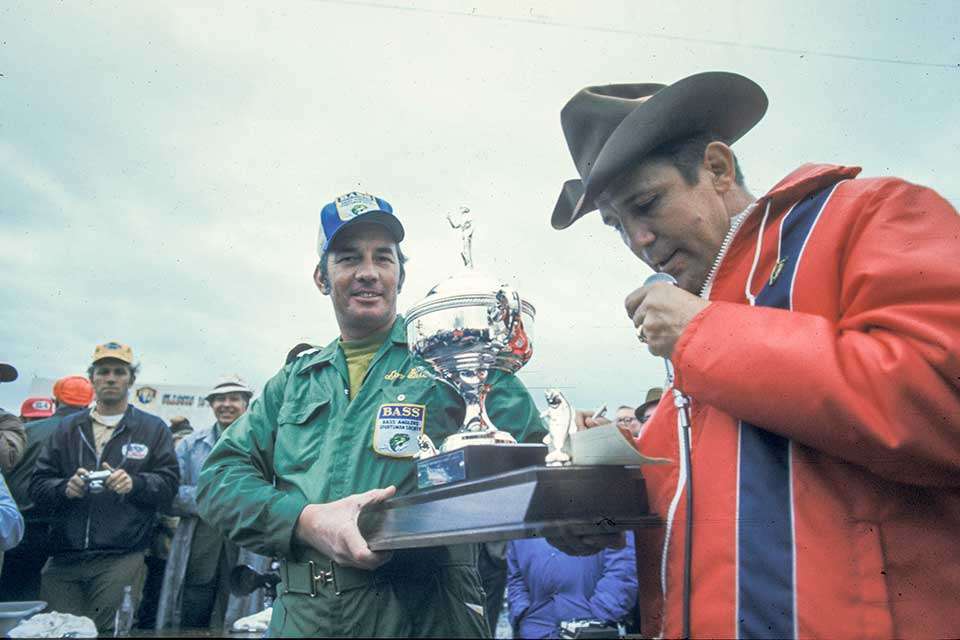
Roger Moore was the first angler who stood out for his fashion, both Precht and four-time Classic champion Rick Clunn said. Precht said the Branson, Mo., angler, not to be confused with the 007 actor, was known as “Dapper Roger Moore” as he wore white knit pants and a red shirt with matching cap.
“It kind of looked like he copied Evel Knievel,” Clunn said. “I thought it was a little loud … the pretty bird gets the girl bird. At the weigh-ins, all the cameras were pointed at Roger Moore, and that’s what the sponsors wanted.”
While the means have changed into more functional clothing, appeasing those sponsors and getting their message to consumers has been the standard in angler clothing over the past half century. Clunn said he always went for quality over quantity in companies he’d represent, whereas he’d joke that Woo Daves was getting fatter so he could fit more sponsors on his increasingly larger shirts.
“Talking about the evolution, most of us early anglers gave it away. A lot of us are just getting caught up,” Clunn said. “Where I was a cheap buy all my career, Skeet Reese is high dollar – you’re going to have to pay for it.
“But for a person who didn’t have a TV show, I had the best sponsorship of anybody at that time – Glastron came in and changed it for me.”
In winning back-to-back Classics in 1976 and 1977, Clunn’s outfits promoted that time’s largest boat manufacturer. For his first title, Clunn wore a blue athletic jacket embroidered with his name and Glastron on one side of his chest and the Classic patch on the other. He said it was like Moore’s outfits but not as wild. In 1977, Clunn wore khaki pants and a maroon rugby style shirt with his name and patches from Glastron and Tackle Tamer. Clunn said he learned early that he only wanted to manage a handful of bosses.
“Every sponsor you have, it’s an invisible string tied to you, and every sponsor sometimes yanks on it,” he said. “If you have two or three, you can respond to the yanks and do them justice. Some guys have 10, and all the sudden, you’re this Pinocchio puppet getting jerked around.”
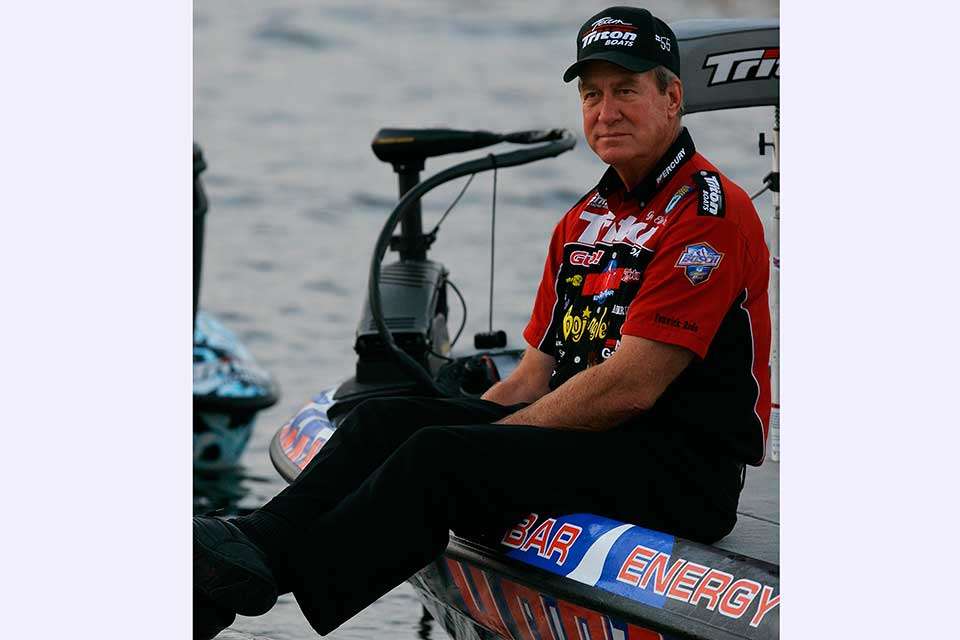
Classing up the joint
Guy Eaker of Cherryville, N.C., was among those wanting to move the needle in angler appearance. While he wore a Carolina blue jumpsuit for some time, he switched to a classier outfit and later coached others to dress nicer.
“Years and years ago, most of the guys wore blue jeans and just a regular old shirt – sort of looked scroungy,” Eaker said. “I thought if we were ever going to be up to par with other sports, we don’t want to look like a bunch of rednecks weighing a fish in. So I started wearing a black pair of pants and a white shirt.”
Wrangler liked Eaker’s style, sponsored him and even made him special pants, complete with a holder for pliers. Another of Eaker’s early sponsors was Jim Bagley, who cleverly thought to run signage down the sides of Eaker’s pant legs.
Many told Eaker that he looked like a preacher who had just come from church. His stately appearance gained monikers of “The Senator” and “The Southern Gentleman.”
Eaker said he also led the way by being among the first to place sponsor patches on his tournament shirts, which was soon to be replaced by more expensive embroidering of logos.
Sponsor patches were worn for years, all the way past Clunn’s fourth Classic title in 1990. Patches paid a lot of bills, but B.A.S.S. also created patches for each tournament from almost the beginning. There were many anglers who placed those event patches on a vest or jacket, and they would wear them at all their fishing functions. As for the pros, many lightened their load for a time. Shirts covered in patches were stiff, heavy and uncomfortable, so a good number of pros went to vests to show their allegiances at weigh-ins.
“They would keep them nice and starched and pressed,” two-time Bassmaster Angler of the Year Davy Hite said. “When they came in to weigh-in, they would put the vest on over whatever shirt they had. It was real handy, but they looked goofy.”
Clunn said vests and shirts with patches went by the wayside because of comfort, or lack thereof. He found clothing with patches in most every available spot was troublesome.
“After you put all the patches on, you kind of felt like an armadillo with a shell, or a knight in armor, because those shirts were so stiff,” he said. “There were several guys who experimented with the vests. They were easier than the shirt, and if it got hot, hot, hot, you could take it off on the water, and put it on for the weigh-in.”
Another reason for the vests was the expense of embroidery. At first, anglers would get shirts from their sponsor with its logo over the pocket and big on the back, then they would embroider their name and add patches from all their other sponsors. Hite said he was one of the trail blazers to have all his signage embroidered, and while these shirts were sharper and gave a crisp, professional look, the cost shot up.
“A sports specialty shop had to do those jerseys,” Hite said. “You had to get the file from these companies of their logos. It was a lot of trouble, and it probably cost $200 to $250 to get all that done.”
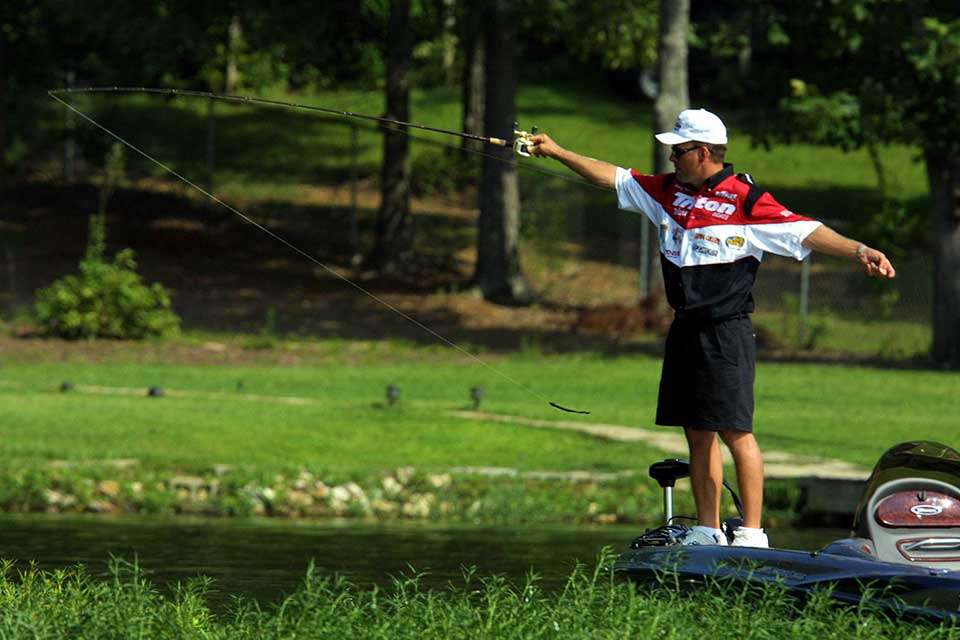
With a handful of shirts, that could close in on $1,000 quickly. These also had to be cared for more diligently. Hite said his would remained stowed until weigh-ins unless he knew he was going to be on camera.
Dress code? Yes, please
B.A.S.S. has at times required certain standards of dress, and one of the biggest ones came after a wardrobe malfunction. While on stage weighing in, an angler in the short shorts of that era bent over while reaching for his fish, and some anglers’ wives saw way more than his bass.
Roland Martin and others were known for shorts going mid-thigh as it was pretty much the standard length at the time, Precht said. (Anglers today still request that Tommy Biffle be required to wear longer shorts).
“George Cochran won the Classic at Louisville, and he had short shorts on,” Precht said. “Larry Nixon had those red short shorts, the kind people wore in basketball at the time. They were cool — breezy.”
B.A.S.S. ended up banning short shorts.
“The dress code, I think was one of the best things that ever happened,” Eaker said.
Precht thinks the only other time the organization really put clothing demands was for the Bassmaster Elite Series, which began in 2006. Blue jeans were even prohibited for a time before B.A.S.S. relented and allowed ones of a certain quality. But the bigger issue was having the anglers conform to a standard.
“There was some resistance when we went to the description of the uniform, and where your name had to be and how big it had to be, where certain patches had to be placed,” Precht said. “They were pushing back. They didn’t want to spend that money on jerseys – but what’s a jersey compared to other costs of competing.”
Especially the new style jerseys that better serve sponsors, are more functional and are even cheaper to make.
Modern shirt for modern man
In a cedar closet in his home, Eaker said he has all his tournament fishing clothes from the time he started. A lot are similar, and differentiate mostly because of a sponsor gained or lost. The crown jewel might be a red jacket that has about 50 patches on it.
“Skeet Reese saw it and said if I ever make the Classic again, I have to wear that jacket,” Eaker said. “I’d wear it.”
Eaker left the Elites a few years ago to help his ailing wife. Now that she’s mobile again, he’s been fishing the Opens trying to requalify for the Elites, which he said is not easy. What is easy are the new high-tech jerseys that have become the norm across all levels of bass fishing.
“It’s nice stuff,” Eaker said. “I think we look the best right now we’ve ever looked, and it gets better every year. They’re neat and look first class, and I think your sponsor gets a better show.”
Looking over a display of encased jerseys in the JM Associates office, Hite said Chris Lane’s jersey from his 2012 Classic win is by far the best, and the wall even included one of his fancy embroidered jerseys.
“These don’t wrinkle like these cotton jerseys did. You had to take care of those, get them pressed, take to the laundry, these you can just pull them right out of your duffle bag,” Hite said. “Just like a truck wrap, they put it on a computer, lay it out, you tell them what placement you want it. And they just hit a button on a computer.”
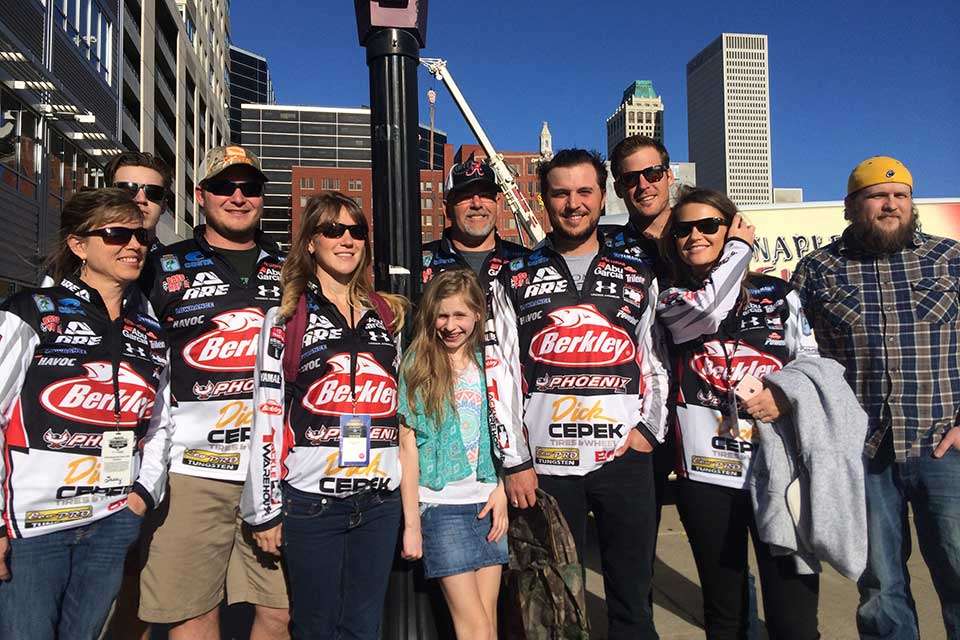
Dan Coates runs Valley Fashions Outdoors in Winnipeg, Canada, one of the companies that make jerseys for a number of Elites. He said each jersey design is a back-and-forth process. The pro picks style and colors and sends images of their sponsor logos with instructions for placement.
“We have over 2,800 logos in our bank,” Coates said. “Humminbird might update their logo and contact us with the new one to use for all their anglers.
“We will send the angler three or four designs, then he’ll narrow it down. Sometimes at the last minute they’ll call and juggle things, then we’ll send another proof. When everything is in place and they say go, then we run production. We’ve had guys pull the trigger literally a week before they need it.”
Coates said a variety of garments are offered along with jerseys, like hoodies, crew necks, quarter zips, etc., in two fabrics that are quick-drying, breathable and moisture wicking. Birdseye is made of 100 percent polyester that is “snagless,” he said, adding it offers some sun protection that improves with certain colors. The UV jersey is a polyester/spandex blend with “a mechanical stretch of 140 percent in wide and 80 percent in the length,” which makes it super comfortable.
“The claim to fame on this fabric is its UPF (ultraviolet protection factor) rating,” Coates said. “The actual test results were UPF 63. It blocks 97.22 percent of UVA and 98.84 percent of UVB. We hang tag it UPF 50-plus.”
Coates said pros typically order a selection of around 10 items costing between $500 to $600 total. On each of them is an angler’s bread and butter, the real estate he has to sell to help make a living.
“For people who don’t know, your bigger sponsors, the ones that pay the most, get the best real estate,” Hite said. “It’s just like buying beach front vs. two rows away from beach. So you can tell by placement and size, who should be paying the most.”
Again, that’s the name of the game. Eaker said he’s been happy to have a 43-year relationship with Earl Bentz, from testing boats for him to riding and fishing out of his Triton, to proudly wearing the name big and bold across his chest.
Clunn, as are most other pros, is the same way with Nitro and Bass Pro Shops. The Zen Master’s jerseys present a clean, clutter-free style to serve his handful of sponsors.
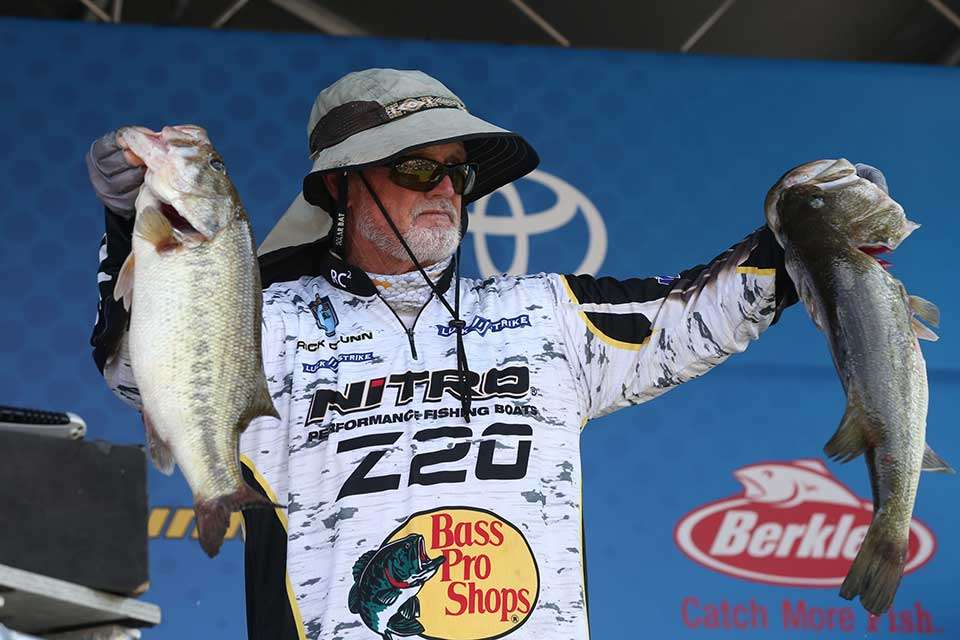
“I’m not that tech savvy, but again, it’s like the super bowl in advertising,” Clunn said. “The better job you do and the more attractive you look to the consumer’s eyes, the more these companies like it. And that’s where these modern jerseys do a whole lot better job.”
Clunn even likes that the new features in jersey design which can make them look “outdoorsy,” like his with a birch bark effect and osprey feathers on the arms.
“Every sport has its own special kind of uniform; NASCAR probably led the way in how we do ours,” he said. “It’s important. Why get camera shots where you can’t read your sponsor? Sometimes we succeed at that and sometimes we fail.”
Social media has really helped companies measure the effect an angler has for them, Clunn said. Before, there was a lot of guesswork. Now, all the platforms allow sponsors to see how much of an impact their guys have, helping them gain insight on where to advertise.
“And it’s evolved from the shirts to, like Skeet Reese’s big truck,” Clunn said. “You really need that big truck? Probably don’t, but his sponsors love it. That’s where he’s smart. He looks at it from the business side and media side where I tend to look at from more of a functionality/practicality side.”
Take a look at angler wear through the years in this gallery, From jumpsuits to jerseys, then check out the different styles the anglers sported in 2018 in this photo gallery.


